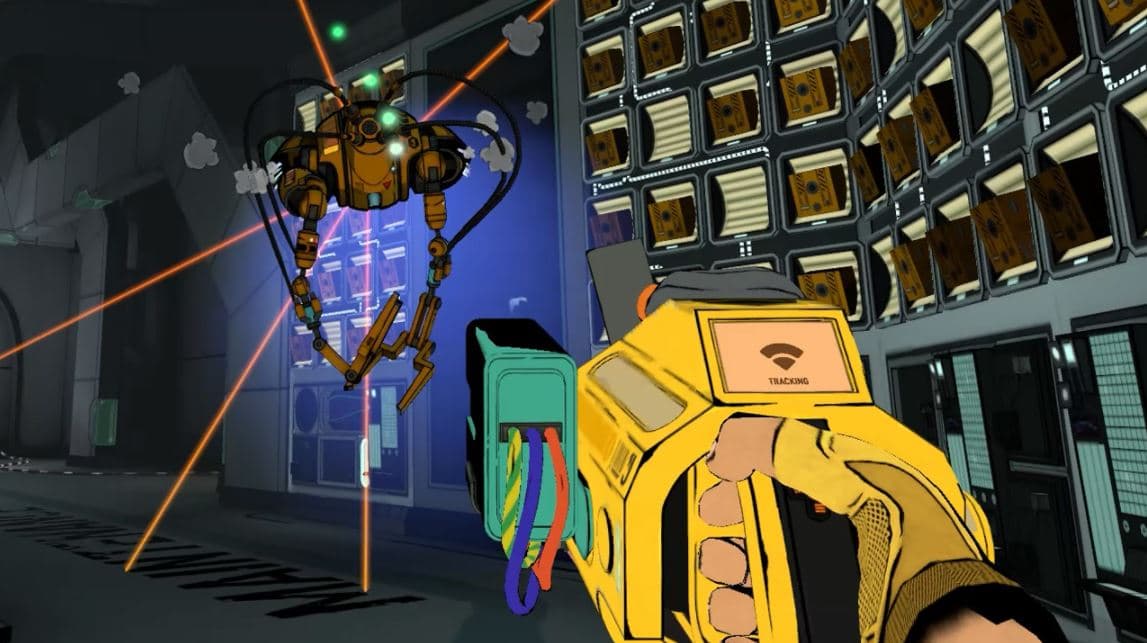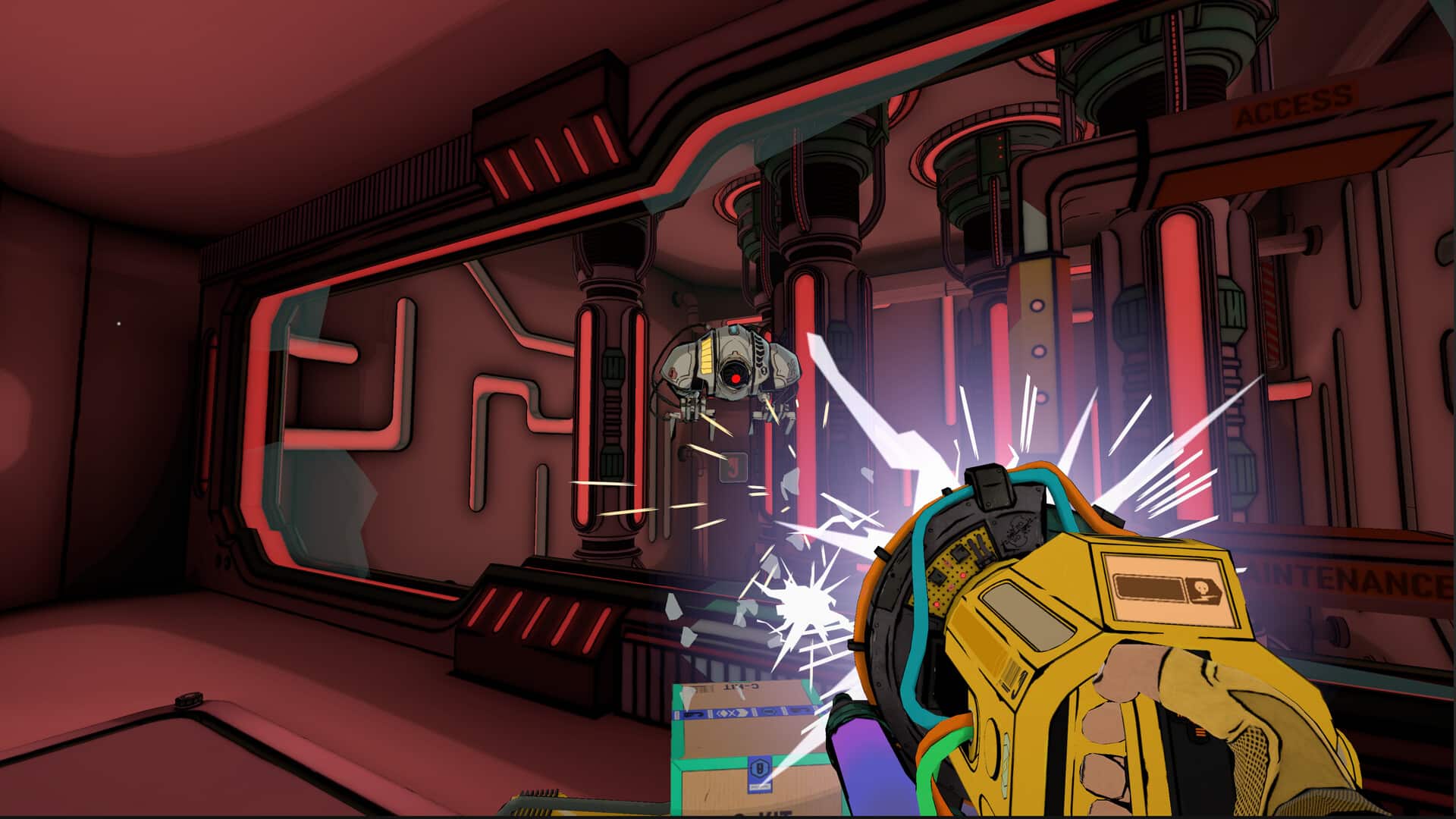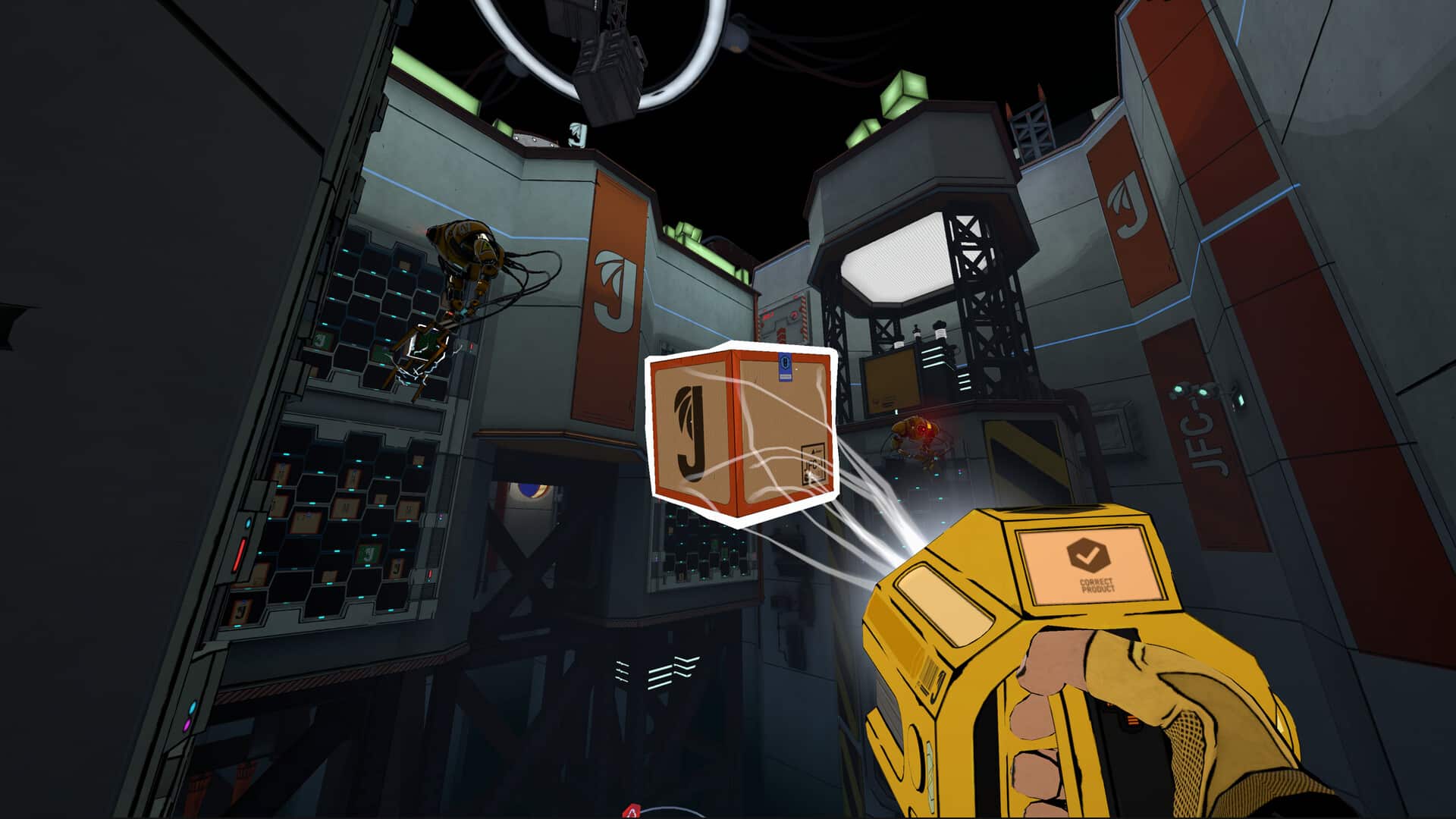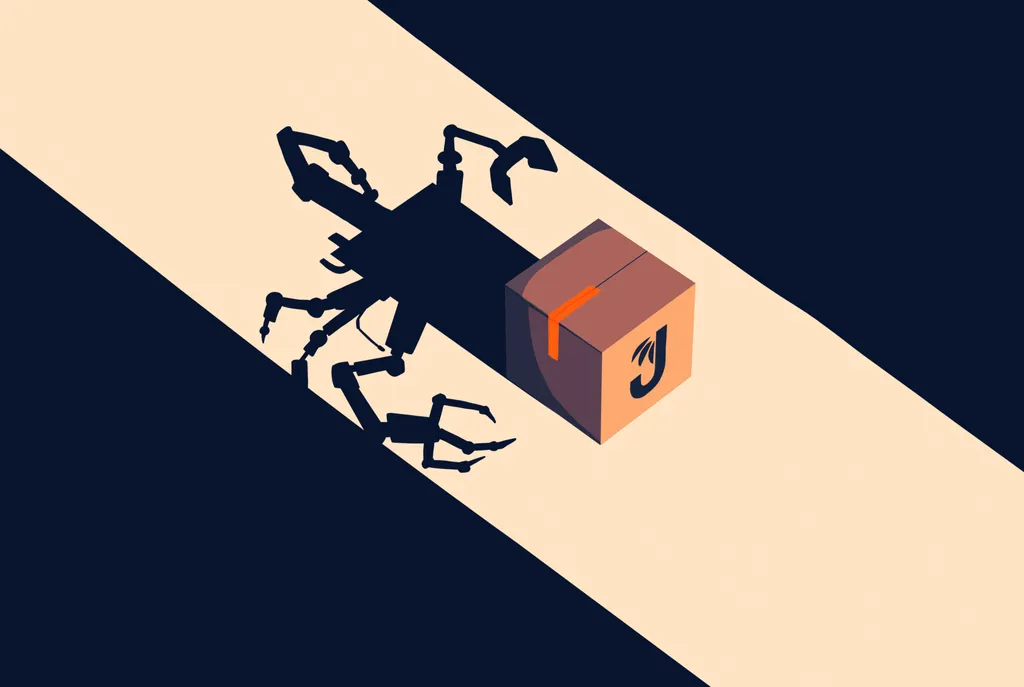The Last Worker brings a narrative adventure to Quest, PSVR 2 and PC VR on March 30, and we spoke with Wolf & Wood founder Ryan Bousfield to learn more.
Oiffy and Wolf & Wood’s dystopian adventure sees you playing Kurt (Ólafur Darri Ólafsson), the last human factory worker at mega-corporation Jüngle, led by its ruthless rainbow-haired CEO. Joined by his robot companion Stew (Jason Isaacs), you’re tasked with helping dismantle Kurt’s employer from within to end rising automation. The cast is rounded out by David Hewlett, Zelda Williams, Clare-Hope Ashitey and Tommie Earl Jenkins. I recently attended The Last Worker’s preview event and went hands-on with the PSVR 2 version.
Thanks to a fault with Skew’s programming, your journey begins with an erroneous first-day tutorial, despite Kurt clearly being a seasoned veteran. Once you’ve cleared this, narrative segments are broken up by Kurt’s day-to-day factory life, you’re tasked with ensuring packages are correctly processed, delivering as many packages as possible within the time limit through his hoverpod. That involves finding them across imposing warehouses, grabbing them with a gravity gun-style ‘JüngleGun’, and assessing whether they’re fine or shipping or need recycling. Every package details its size and weight, the latter being assessed once placed onto your pod. If the information doesn’t match the packaging labels or it seems damaged, send it to recycling.
Warehouse work isn’t the most exciting premise for a video game but The Last Worker tries mixing the grind with humor and incentivizes you to do better through a ranking system. If you fail, you’re fired and even if you pass, your boss can’t resist providing “encouraging” feedback, which leans well into the game’s satire. Unlocking that gold PlayStation trophy for top marks on my third try was nice. It does a great job illustrating Kurt’s situation, while the handpainted art style adds character to these depressing halls. I’m intrigued to see how writer/director Jörg Tittel handles this story and it didn’t take long before I was invested.
I didn’t get a chance to try the stealth sections but I left the preview feeling positive after finishing chapter 1. Following a lengthy hands-on session, I sat down with creative director Ryan Bousfield to learn more:
UploadVR: First off, thank you for talking with me. To start at the beginning, how did development and gameplay come together for The Last Worker?
Bousfield: So, Jörg Tittel had the idea way before meeting Wolf & Wood. It’s something that we were looking to get made and we did some tests, working with Mick McMahon (Judge Dredd, 2000AD) on character ideas. It’s something that he had in the background for many years. I was put in contact with [Jörg Tittel] through a friend who said, “We’ve been looking at making this game but something’s come up, we don’t have the capacity.”
Because Wolf & Wood have a background in narrative, he said “would you be interested in talking to him and just seeing what you think?” So, I chatted to Jörg; we sorted the pitch for The Last Worker and created an outline idea of this near-future dystopia that’s also colorful, bright and weird. The idea of having these robots flying around this giant facility with you as the last human in that set up.
It sounded interesting and weird, something leftfield. That’s what we like making at Wolf & Wood. We’ve done horrors with Hotel R’n’R, smashing up hotel rooms for the devil. None of it’s just shooting and killing things; it’s always been something like scaring people. We’ve always leaned more towards narrative. From there, we got into some really nice ideas, I thought “let’s try and get a publisher on board” and, a year later, we connected with Wired Productions.
I think everybody involved is taking a chance on it, it’s quite an unusual pitch. But at heart, it’s a narrative game where we weave together different types of gameplay as you’re working through it. We were trying to move gameplay along, so you can keep players on their toes. None of it is massively taxing, stealth areas have a very quick turnaround on checkpoints. So, even if you fail the set up, you’re not dead; you get fired, and there’s responses from Josef Jüngle, the CEO.

UploadVR: I’ve seen that first-hand while playing. I scored an F [during a warehouse mission], got fired, and on my second attempt, I scored a B. He then told me “you could B better.”
Bousfield: It’s that sort of light, almost adventure game-esque humor. We’re aiming for that nice pacing with everything that keeps you moving, you always feel a sense of progression. As we push the character, we push the player into more dicey situations where you get a sense of danger. We’ve been calling it stealth-lite, where you’re not looking and mapping out your route in minute detail. You can get an idea of the situation, then you can fly in, try a path and if something turns around, you can reverse and get out of the way.
UploadVR: Even in the stealth sections, are you still in the vehicle?
Bousfield: Yeah, and we’ve got full 6 degrees of freedom. In VR, you can obviously take yourself out of the space and pot around a bit. That gives us some interesting situations for stealth scenarios as well, there’s not many games where you’re in flying pods. It’s a new, unique challenge to this. We can’t just go to the rulebook of flying stealth.
UploadVR: It’s definitely not what you’d normally think of, hiding behind the boxes with the pod. Or like Solid Snake hiding in the box.
Bousfield: Considering it’s a game where you’re in a warehouse full of boxes, we don’t actually do that. There were definitely ideas about some stages but, yeah. We have flatter areas where you’re moving around avoiding boxes in a more traditional pattern… Each one is like a little vignette of a segment rather than a big open world.
UploadVR: You’ve also been developing C-Smash VRS alongside this, how has it been managing two projects of this scale side by side?
Bousfield: We just had to really work at it, we all pulled together and managed our time as best as possible. Wolf & Wood is only a seven person team, there’s people involved in both projects such as musicians, concept artists. It’s been a lot from that side, but as one’s kind of coming to an end, we’ve got the full version to do after that. I think we misjudged the timing a little bit with both landing so close together, but it does take years to do projects scale. So it’s very difficult to judge this stuff ahead of time. It’d be lovely to have a nice clean calendar but the nature of these opportunities that present themselves. There are some things that we don’t want to say no to.

UploadVR: Because you’ve got The Last Worker running on every major platform, was it always designed with VR first? Or was it flat and you then adapted into VR?
Bousfield: It’s been developed in tandem. During the course of development, we knew that the VR version would be the initial challenge with getting a player onto a vehicle and moving them around in a giant space. So we went there first and then into the flat version, which initially had these tank controls because that’s how you essentially move the pods. We tried doing that in flat but it didn’t translate, it didn’t feel snappy.
UploadVR: What did you do to get around that?
Bousfield: We went back to more traditional FPS control. The Pod, for the most part, it’s an extension of you. In first person, you don’t think about controlling the feet, you’re controlling the head and everything else follows. We refined that to get the snappy first person control, which really does translate well onto controllers. I think it feels good on Switch especially, which has the gyro controls. It has been crazy looking at all the different versions, control schemes and everything else we’ve got to consider. But at the core, it’s the same game. It should look and feel very similar across all platforms.
UploadVR: Thinking specifically with VR. You’ve got it running on Quest 2, Quest Pro, PSVR 2 and PC VR. Are there any big differences between how it runs on these headsets?
Bousfield: The biggest difference is the performance power you have. With controls and designing for all the different headsets now, they’re very in sync. When you look at the Quest 2 controllers compared to PSVR 2, they’re not that different compared to [Vive Wands]. From a design perspective, I do like that these controllers are becoming the standard. VR itself is not very standard anyway. You can do so much in the headset. You have to consider things like, what if somebody looks under a table? That’s something I didn’t need to worry about previously. Now it’s like, what if somebody puts their head in the corner? What if somebody tries to play lying down?
UploadVR: If people can, they will try.
Bousfield: Exactly. So it’s great that the hardware companies have kind of agreed to a design standard, which is great for us as developers. The biggest challenge is, how do you get something that looks good on PS5 and PSVR 2 running on a device that just doesn’t have the same GPU power?

UploadVR: Is that where the stylized art comes in?
Bousfield: Definitely. That’s a big thing from a technical standpoint, everything is handpainted. We have that real-time lighting and shading on characters to give us a sense of depth. But the details, scuffs, all the marks, the hairs and beards, they’re all hand drawn in. That helps it looks really nice and embodies this chunky style, like when you see Kurt’s sausage fingers. That helps it excel across all different platforms, giving continuity between high-end and where we’ve got to optimize more.
UploadVR: As a quick technical question with PSVR 2 since it’s been a hot topic, what is the refresh rate and framerate for The Last Worker?
Bousfield: So, we’re currently running 60Hz with reprojection to 120Hz in PSVR 2. That said, we’re looking at all options and this may change.
UploadVR: Regarding the Switch version, did you ever look at using Nintendo Labo and the cardboard VR for it?
Bousfield: Ah yes, very early in the conceptualisation of The Last Worker, Labo was something we chatted about but it was one of many ideas floating around. A cardboard representation of the JüngleGun does still sound like fun – given that the game is, on one level, about dispatching cardboard boxes!
UploadVR: Finally, you’ve got such a strong cast that we don’t normally see in VR games, how did that come about?
Bousfield: So, Jörg’s background is in comics, films. He’s got contacts, so he hit them up, showed them a prototype. He sent me a video of [Jason Isaacs] at his house, testing it out one of the very early builds. We were frightened about showing it so early. When we were in lockdown [with COVID-19], it sounded like we could make the schedule work. You had people working from the kitchen, or with [Ólafur Darri Ólafsson], a studio in Iceland.
The Last Worker arrives on March 30 for the Meta Quest platform, PSVR 2 and PC VR for $19.99. A flatscreen release is also planned for PC, PS5, Switch and Xbox Series X|S.























